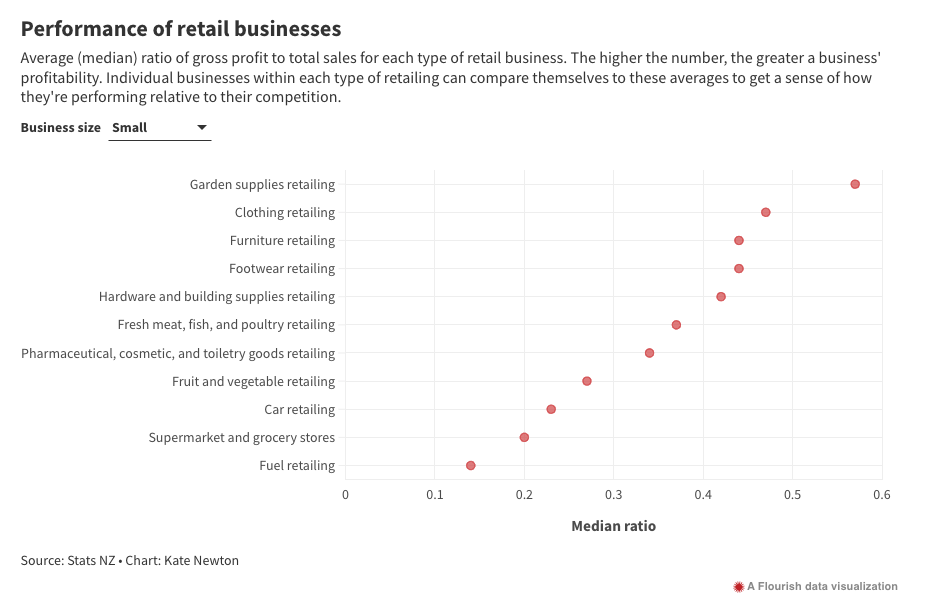Which NZ products have the largest mark-ups?
RNZ
09 July 2024, 3:01 AM
 The strongest margins are in "vertical retailers", who sell their own products to consumers. Photo: RNZ / Rebekah Parsons-King
The strongest margins are in "vertical retailers", who sell their own products to consumers. Photo: RNZ / Rebekah Parsons-KingWhen it was recently revealed that Italian prosecutors looking into LVMH subsidiary Dior's use of third-party suppliers had found that it paid US$57 - excluding some materials - to produce bags that sold for $2870, it might have come as a shock to some luxury shoppers.
But Dior chief executive Delphine Arnault's father is the world's third-richest person - Bernard Arnault - so perhaps it's not surprise that they know how to turn a profit.
It prompted RNZ to investigate which New Zealand products might possibly have the largest mark-ups.
While it's hard to get a perfect picture because the data is often commercially sensitive, you can get a sense of it from Stats NZ, which compiles data regularly on the gross profit ratio of various sectors.

The caveat to the data is it will not include operating expenses, interest or taxes.
While taxes should be consistent across businesses, operating expenses and interest could be varied depending on how much online versus physical retailing is happening and how many staff are employed.
But at a high level, it shows that for micro retail businesses, marine equipment retailing is currently the most profitable sector.
But among small, medium and large businesses, antique and used goods dealers are making the largest profits.
Chris Wilkinson of First Retail Group said antique and used goods retailers were probably more profitable because shoppers had nothing to compare their prices to.
"If you've got a unique piece of whether it be art… you can't say I could get that down the road for this price."
Across all business sizes, gardening businesses tended to be more profitable than clothing, which was marginally ahead of furniture and footwear - but among large businesses, they were very similar.
Wilkinson said the strongest margins would be in businesses that were "vertical retailers" - selling their own products to consumers rather than selling other manufacturers' goods.
"More and more we see high streets and malls filled with retailers that are actively selling their own products, versus 10 or 15 years ago the streets were filled with retailers with products from lots of manufacturers. Another aspect is retailers that are selling directly, like the Levi's store or Dyson."
He said Kmart had differentiated itself from The Warehouse in this way, and it gave it the same advantage the antique dealers had - customers could not compare the products' prices elsewhere.
Unlike Gucci, Wilkinson said in New Zealand, higher-end garments would generally have less margin than that sold by businesses such as Hallenstein Brothers and Glassons.
"There's margin there but it has to be good because these retailers have large stores, infrastructure - it's expensive."
Fuel retailing and car retailing were among the least profitable by this measure.
MBIE monitors fuel importer margins and said the margin on petrol was about 35 cents per litre - but fuel retailers would have to cover costs such as transport, distribution and the cost of providing fuel from this.
Motor Industry Association chief executive Aimee Wiley said her understanding was that car dealer margins for a new car sale were wide-ranging and variable.
They could as low as 0.5 percent and 1 percent to 2 percent was not uncommon, she said.
Supermarkets were also near the bottom of the Stats NZ data, but senior lecturer in Otago University's department of marketing Rob Hamlin said margins were not consistent through a supermarket.
He said the higher-margin items were positioned at the start of of supermarkets.
"You are kind of encouraged to go around the supermarket in a certain way - the early parts of the journey are a pleasant place to be as it's attempting to slow you down and turn you around and keep you in that part of the store. Then all of a sudden when you arrive at a certain part of the store, the whole layout changes... at that point they've got you through all the high-margin parts, now they just want to get you out of the store.
"They've made their money selling you cakes and meat and bananas but they know to get you to come back every week you have to be able to buy beans and bleach and bog roll."
He said "mouse trap cheddar costing $20 a block" often captured attention but could take 14 months to make. "If you go to the specialist cheese and look at the soft and squishy French style that don't take two ticks to produce, and work out per kilogram, some can be $60 or $80 or $100 a kilogram. The margins in that part of the supermarket are extremely attractive."
Woolworths said in its 2023 financial year, it made 0.8c for every dollar spent.
None of the mark-ups appear to be on the same level as Gucci's - and Wilkinson said New Zealand retailers were facing more competitive pressure than ever.
"It's really related to the multitude of channels that are now available. There's online - all these other aspects of competition from overseas retailers coming to New Zealand."
He said market demand could change rapidly.
"I would say it's more dynamic than it's ever been... At certain times there might be a flavour of the month that can do no wrong, and now it's completely different."



